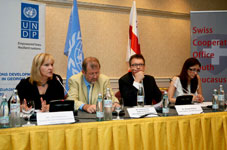
What hinders Georgian agricultural development?
By Gvantsa Gabekhadze
Friday, July 5
Employment, growth, poverty reduction and food security make agriculture one of the most important economic sectors in Armenia, Azerbaijan and Georgia, according to the UNDP research project Comparative Analysis of Agriculture in the South Caucasus. Research was conducted by a team of international and local experts; the project was commissioned by the United Nations Development Program (UNDP) in Georgia with funds from the Swiss Agency for Development and Cooperation (SDC) and was presented on July 4th at the Tbilisi Marriott Hotel.
The research compares the status and prospects of agriculture in the three South Caucasian countries and assesses its potential impact on development. It also examines a range of factors, such as state policy, access to market and finance, productivity, quality, competition and land use.
Despite the fact the research was conducted before the parliamentary elections of 2012, those problems touched upon in the report are still present. According to George Welton, lead author of the project, of all post-Soviet states Georgia was the most affected in terms of agriculture by the breakup of the Soviet Union.
"There are three key elements why this happened: first, Georgia produced more than the other countries and so had far further to fall. Second, the level of state collapse and lawlessness was greater and lasted longer; and third, none of the major elements of infrastructure had improved significantly until relatively recently." Welton stated, adding that irrigation is still a major problem for Georgian agriculture.
Walton stated that Armenia and Azerbaijan managed to solve their irrigation problems and unlike Georgia have increased exports of beef and agricultural products.
Land registration is crucial for the development of a commercial agricultural market and for encouraging commercial agricultural investment. "Current procedures of land registration are too expensive, confusing and frightens investors." Welton suggested.
Welton shifted attention on farmers' cooperatives that have proposed as a solution by the current Georgian government. According to him the system might work successfully in Georgia. However, he advised that the Azeri and Armenian farmer cooperative systems should not be used as a model in Georgia.
Education was named as one of the main hindering factors for agricultural development in Georgia. Small farmers have no access to modern agricultural methods.
According to the report, if Georgia wishes to have a presence in Western markets it should update its production standards. In response to the The Messenger's question concerning Georgian products returning to Russia, Welton suggested that Georgia will have to think more about product quality as in eight to ten years the Russian market might have the same standards and demands as Western markets.
"In the absence of the Russian market, the majority of Georgian products now go to a number of post Soviet and Eastern European states, where the Georgian brand is still strong and neither volume requirements nor quality standards are as high as they would be in Western supermarkets. Of course, given the erratic nature of the Russian authorities, it might be a risky strategy to organize investment strategy around a Russian-export plan, but how long it will take Georgian suppliers to overcome their nervousness is also hard to judge." the survey suggested.
In Georgia, policies towards agriculture are consistent and market oriented. The report suggested that the Georgian government should first focus on structural problems like education, irrigation, animal health, land-ownership and cooperatives.
Lita Surmava, Head of the International Relations Division of the Ministry of Agriculture, stated that since the current Georgian government came into office, attitudes towards agriculture have been completely changed and have become a priority.
She thanked those who undertook research and organized the project, stressing that such surveys are important for the ministry in its path towards the complete modernization and transformation of the Georgian agricultural system.

